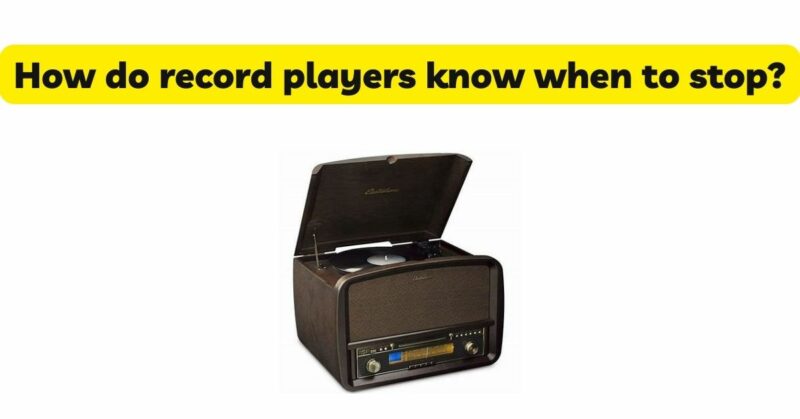Record players have been enchanting music enthusiasts for decades, providing a unique and immersive listening experience. One intriguing aspect of these analog devices is their ability to know when to stop playing a record. Have you ever wondered how record players detect the end of a record and gracefully come to a halt? In this article, we will delve into the mechanisms behind this intriguing functionality. We will explore different methods employed by record players to determine when to stop, including manual and automatic approaches. By understanding the technology at play, you can gain a deeper appreciation for the intricacies of record players and their ability to deliver a seamless musical experience.
- Manual Stop: The most straightforward method of stopping a record player is a manual stop. With this approach, the listener determines when to stop the record by manually lifting the tonearm from the vinyl surface. This method provides complete control and flexibility but requires attentive monitoring of the playback and precise timing to avoid unnecessary wear or damage to the record.
- Run-out Groove: Another common method used by record players to detect when to stop is through the use of a run-out groove. At the end of a record, the run-out groove contains a spiral or concentric groove that leads the stylus toward the center of the record. As the stylus encounters the groove, it causes the tonearm to gradually move toward the center of the platter, eventually lifting the needle and stopping the record. This method ensures a smooth and automatic stop without requiring external intervention.
- Lead-out Groove: Similar to the run-out groove, the lead-out groove also plays a role in determining when to stop the record. The lead-out groove is located immediately after the last track on a record. When the stylus reaches the lead-out groove, it encounters a continuous groove with no modulations or sound. This lack of audio signal alerts the listener that the record has reached its end, signaling them to manually lift the tonearm and stop the playback.
- Mechanical Devices: Some record players incorporate mechanical devices or mechanisms that automatically stop the record at the end. These devices can include a mechanical arm or lever that senses the position of the tonearm and engages a stopping mechanism when it reaches a certain point. These mechanical solutions provide convenience and ease of use, ensuring that the record stops automatically without the need for manual intervention.
- Optical Sensors: In modern record players, optical sensors are sometimes utilized to detect the end of a record. These sensors are typically positioned near the center of the platter or along the path of the tonearm. As the stylus reaches the innermost grooves or moves closer to the center, it triggers the optical sensor, which then sends a signal to the turntable’s motor to stop the rotation. This method allows for precise detection of the end of the record, resulting in accurate and consistent stops.
- Electronic Sensors: Some advanced record players employ electronic sensors to determine when to stop the record. These sensors can include proximity sensors or capacitive touch sensors integrated into the turntable’s platter or tonearm mechanism. When the stylus approaches the center or encounters specific areas on the record, these sensors detect the change and send a signal to the turntable’s control circuitry, instructing it to stop the playback.
- Integrated Timer Mechanisms: Certain record players feature integrated timer mechanisms that allow users to set a specific duration for the record to play. These mechanisms can be analog or digital, enabling the turntable to automatically stop at a predetermined time. This functionality is particularly useful for those who want to control the duration of the listening session or wish to fall asleep while listening to music.
- User-Activated Stop Buttons: Some record players include user-activated stop buttons or switches that allow listeners to stop the record manually. These buttons are typically located on the turntable or the accompanying control panel. By pressing the stop button, the user interrupts the rotation of the record and lifts the needle from the surface, effectively stopping the playback.
Conclusion: The ability of record players to know when to stop is a result of various mechanisms and technologies employed by different models. From manual intervention to run-out grooves, optical and electronic sensors, and integrated timer mechanisms, record players utilize a range of methods to ensure seamless and accurate stops. Whether you prefer the manual control of lifting the tonearm or the convenience of automatic mechanisms, record players have evolved to provide options for all types of users. By understanding these mechanisms, you can gain a deeper appreciation for the engineering and innovation behind these timeless devices that continue to captivate music enthusiasts around the world.


